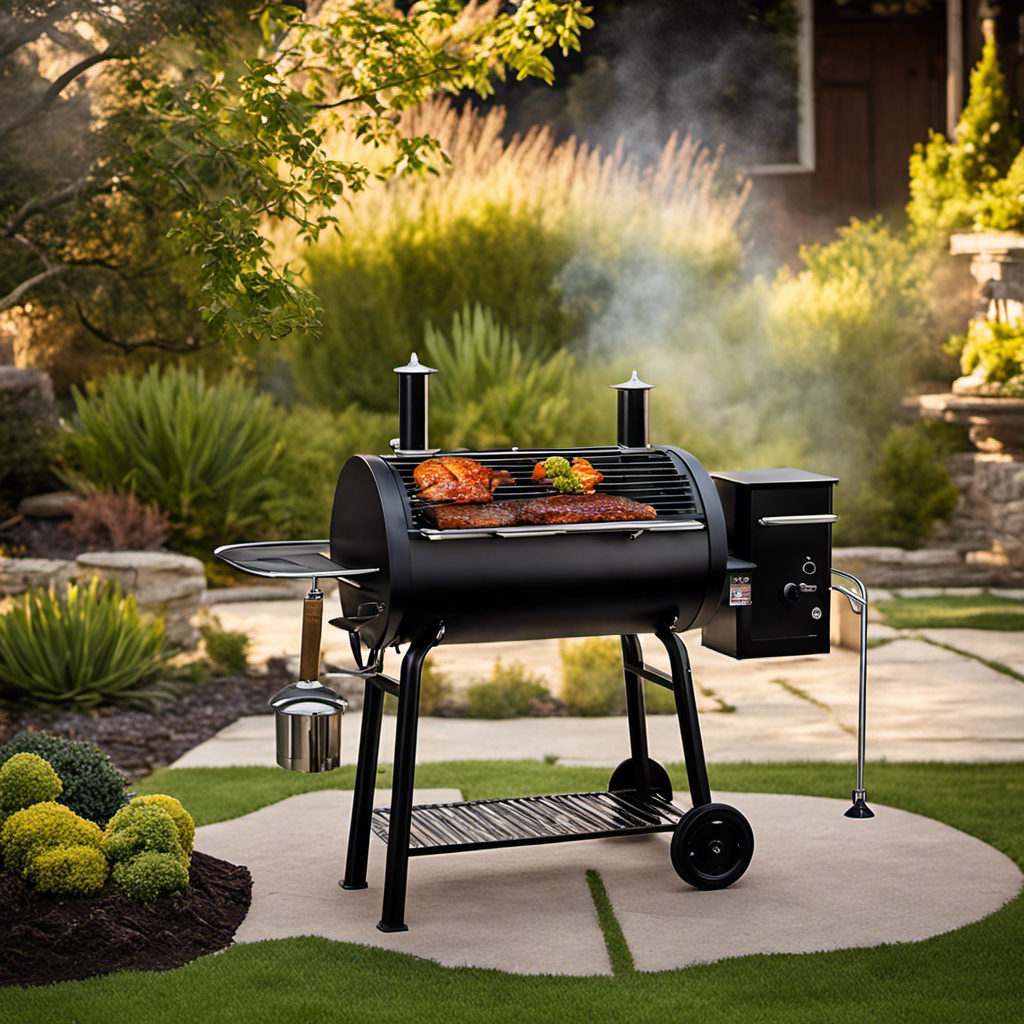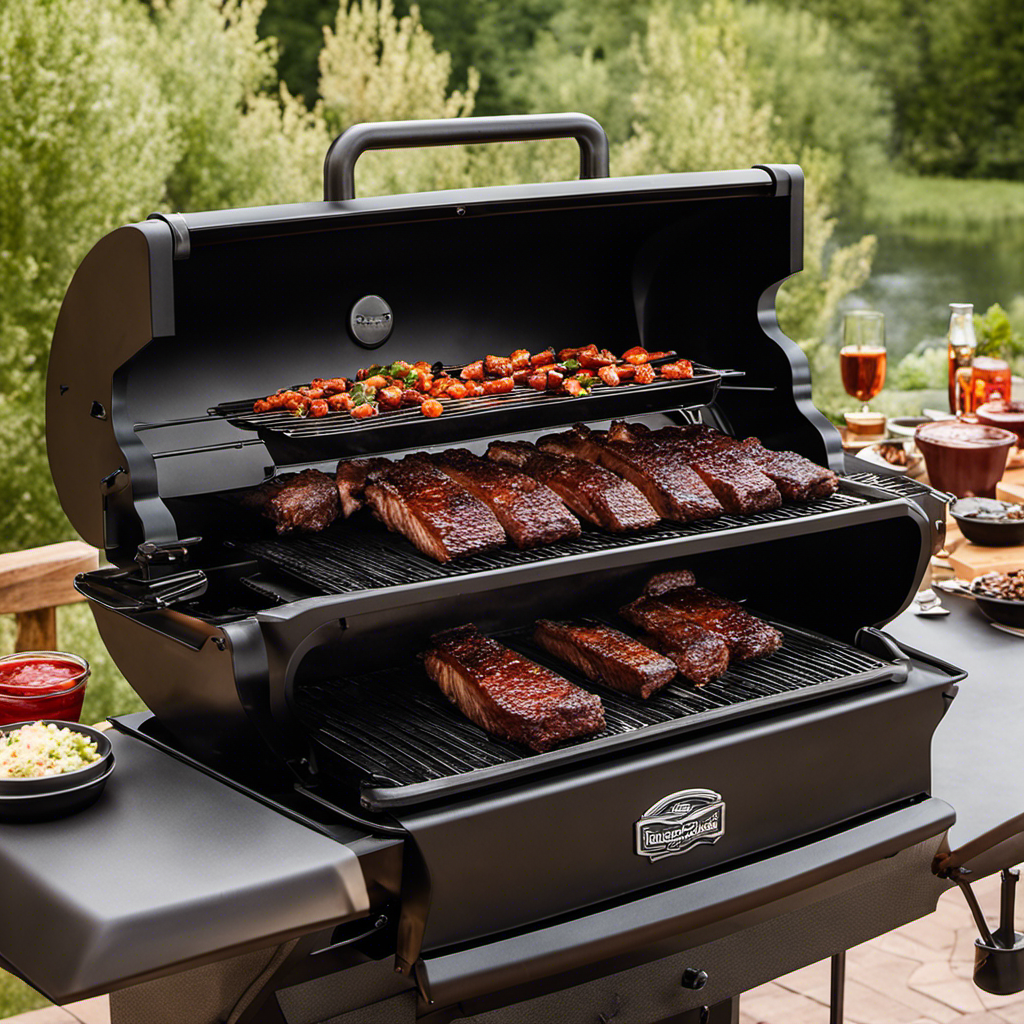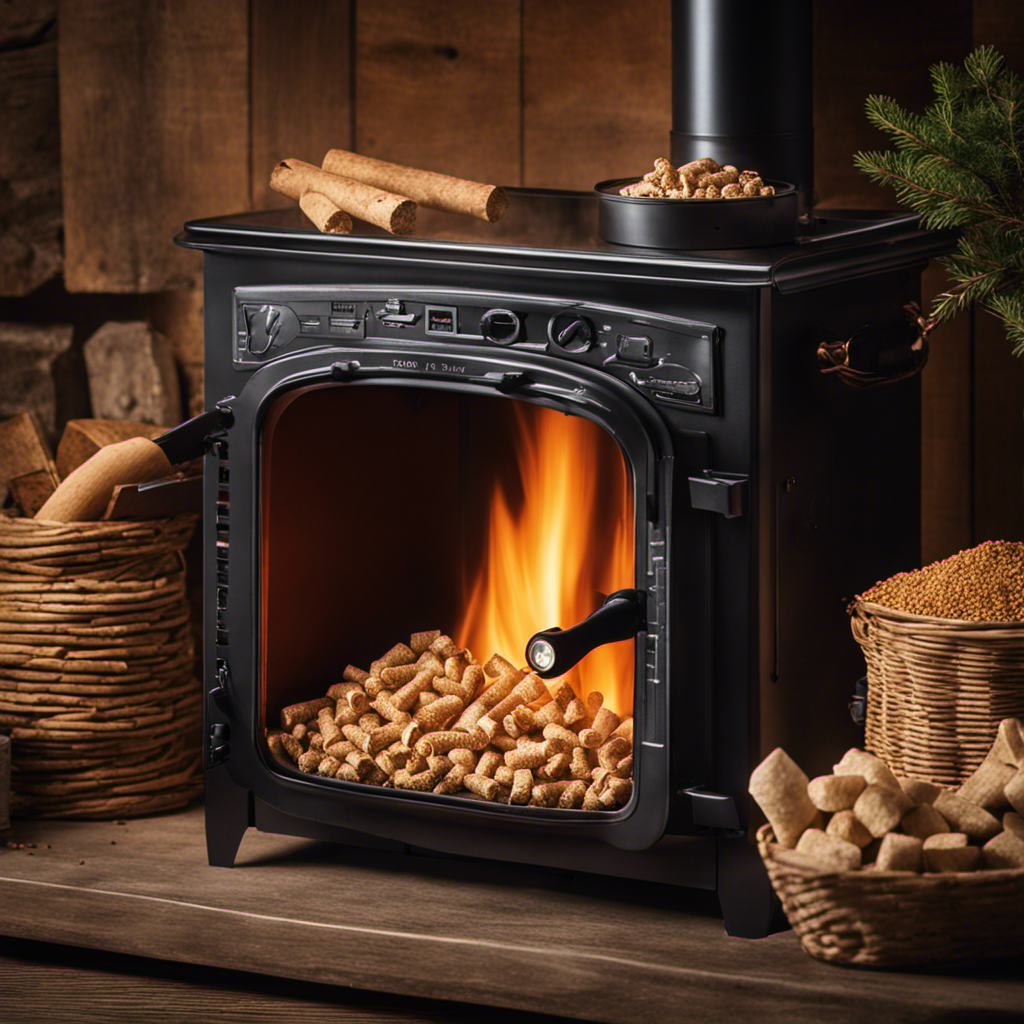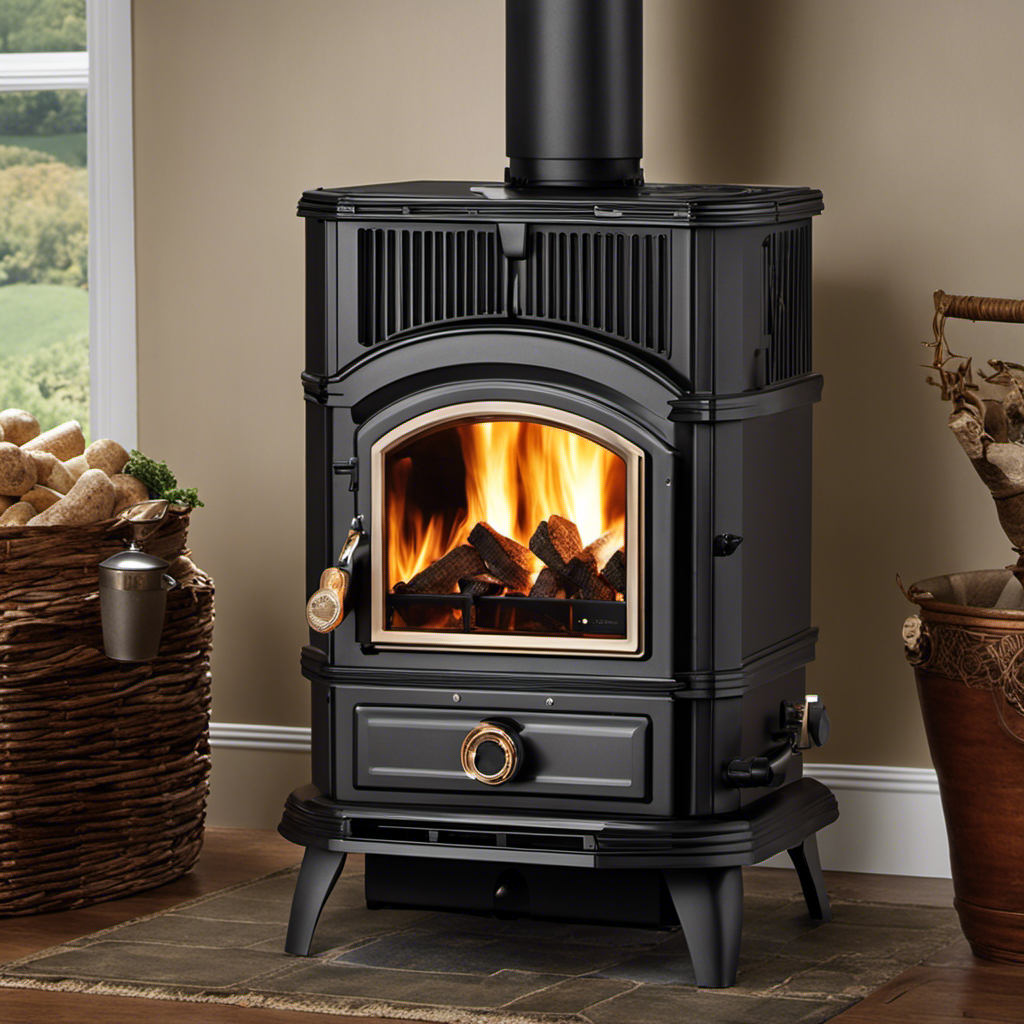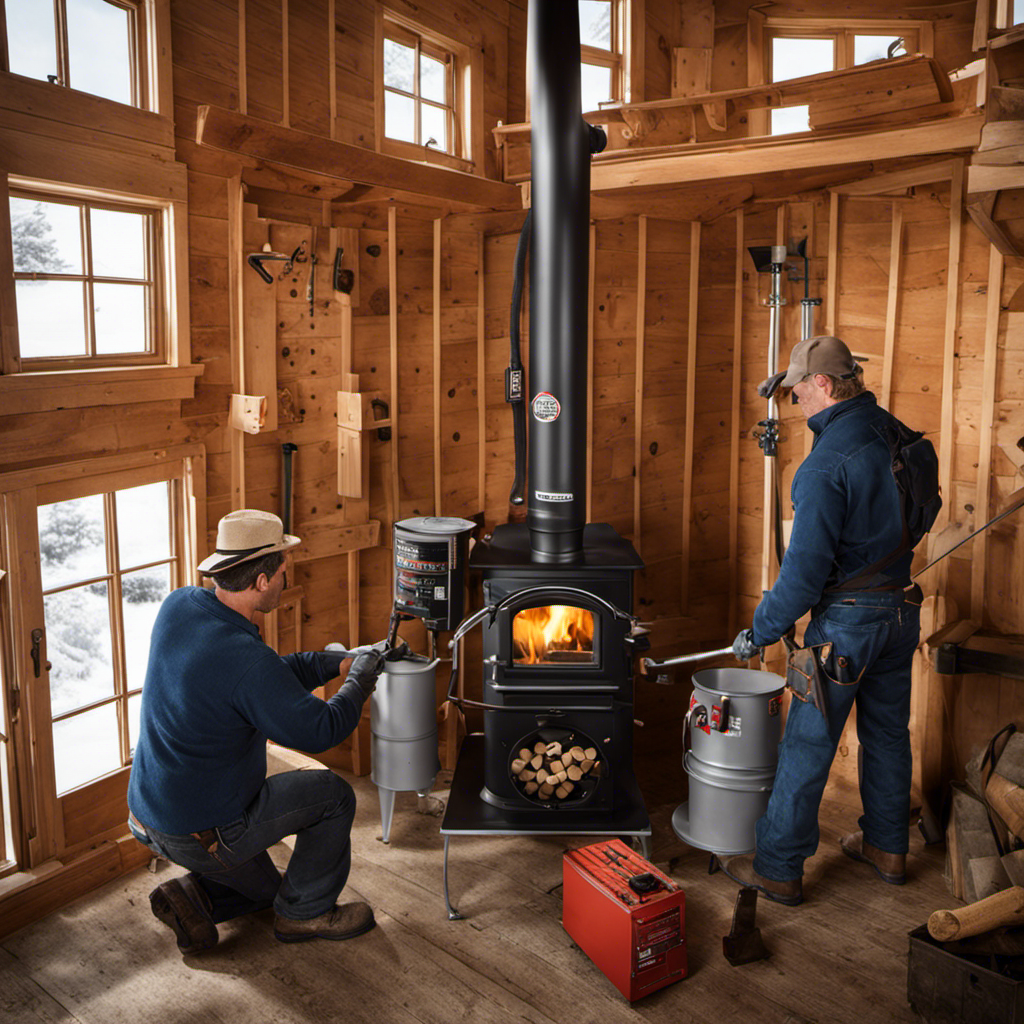As I fire up my wood pellet grill, the atmosphere fills with the anticipation of the savory smoke aroma, invigorating my senses. Today, I’m thrilled to lead you through the precise steps for flawlessly smoking a tasty spatchcocked chicken on your grill.
With my expert guidance, you’ll learn how to choose the perfect wood pellet flavor, season the chicken just right, and set the grill temperature for optimal results.
So, grab your apron and let’s embark on this mouthwatering culinary journey together.
Key Takeaways
- The choice of wood pellet flavor can greatly impact the smokiness and taste of the split chicken, with options ranging from strong and bold (hickory) to subtly sweet and fruity (apple and cherry).
- Properly preparing and seasoning the chicken, whether through brining, marinating, or allowing it to absorb flavors, is key to achieving a delicious and succulent final product.
- Preheating the wood pellet grill is essential for even cooking, while setting the temperature and smoke level correctly is crucial for different cuts of chicken to avoid drying out or becoming tough.
- Following the smoking method, using a meat thermometer to monitor internal temperature, and allowing the chicken to rest after cooking are all important steps in achieving perfectly smoked, tender, and flavorful split chicken.
Choosing the Right Wood Pellet Flavor
When choosing the right wood pellet flavor, it’s important to consider the level of smokiness you want in your split chicken. The flavor of the wood pellets plays a crucial role in enhancing the taste of your smoked chicken.
There are various flavors to choose from, such as hickory, mesquite, apple, cherry, and oak. Each flavor imparts a unique smokiness to the meat, so it’s worth experimenting with different flavors to find your favorite.
Hickory pellets offer a strong, bold smoky flavor, while mesquite provides a more intense, earthy taste. Apple and cherry pellets add a subtly sweet and fruity note, perfect for poultry. Oak pellets, on the other hand, deliver a milder, well-rounded smokiness.
Once you’ve selected the perfect wood pellet flavor, it’s time to prepare the split chicken for smoking without any delay.
Preparing the Split Chicken for Smoking
To start prepping the split chicken for smoking, you’ll want to season it with your preferred spices and let it sit in the fridge for at least an hour. But before that, consider brining the chicken to lock in moisture and enhance flavor. Brining involves soaking the chicken in a saltwater solution, allowing the meat to absorb the liquid. This process not only helps keep the chicken juicy during smoking but also adds a subtle hint of saltiness.
If you prefer more complex flavors, marinating the chicken is another option. This involves coating the chicken in a flavorful mixture of herbs, spices, and liquids such as vinegar or citrus juice. Whether you choose to brine or marinate, giving the chicken time to absorb the flavors will result in a more delicious and succulent final product.
Once the chicken has been seasoned and allowed to rest, it’s time to move on to the next step of preparing it for smoking.
Now that the split chicken has been seasoned and allowed to rest, it’s ready to be smoked to perfection.
Seasoning the Chicken
Once you’ve chosen your preferred spices, simply rub them onto the seasoned chicken for added flavor. The right combination of spices can elevate the taste of your smoked chicken to a whole new level. Whether you prefer a savory or spicy profile, there are endless possibilities when it comes to seasoning. To help you get started, here are three popular options:
| Spice Blend | Ingredients |
|---|---|
| Classic BBQ Rub | Brown sugar, paprika, garlic powder, onion powder, salt, black pepper, cayenne pepper |
| Herbs de Provence | Thyme, rosemary, oregano, marjoram, basil, lavender, salt, black pepper |
| Smoky Chipotle Rub | Chipotle powder, cumin, garlic powder, onion powder, brown sugar, salt, black pepper |
Experiment with different combinations or try out one of these tried-and-true blends. Allow the chicken to marinate in the spices for at least an hour, or for even more flavor, consider brining the chicken beforehand. This will ensure that the flavors penetrate deeply into the meat, resulting in a moist and flavorful smoked chicken.
Now that the chicken is seasoned to perfection, it’s time to move on to the next step: preheating the wood pellet grill.
Preheating the Wood Pellet Grill
Now that you’ve seasoned the chicken, it’s important to preheat the grill for optimal cooking temperature.
Preheating the wood pellet grill offers several benefits. Firstly, it ensures even cooking throughout the chicken, preventing any raw or undercooked areas.
Secondly, preheating helps to sear the outside of the chicken, locking in the juices and creating a delicious crispy skin.
The recommended preheating time for a wood pellet grill is around 10 to 15 minutes. This allows the grill to reach the desired temperature and ensures that it is ready for cooking.
Once the grill is preheated, it’s time to move on to setting the temperature and smoke level, which will further enhance the flavor of the smoked chicken.
Setting the Temperature and Smoke Level
When it comes to smoking meat on a wood pellet grill, two key factors to consider are the optimal temperature for smoking and achieving the desired smoke flavor.
The optimal temperature for smoking varies depending on the type of meat you are smoking, but generally falls between 225°F and 250°F.
Achieving the desired smoke flavor requires finding the right balance between the amount of smoke produced and the time the meat spends in the smoker, ensuring a delicious smoky flavor without overpowering the taste of the meat itself.
Optimal Temperature for Smoking
To achieve the best results, it’s important to maintain the optimal temperature while smoking a split chicken on a wood pellet grill. The optimal smoking time for a split chicken is around 2-3 hours, depending on the size and thickness of the meat. Adjusting the temperature is crucial when smoking different cuts of chicken. For example, bone-in chicken thighs require a slightly higher temperature to ensure that the meat cooks through without drying out. On the other hand, boneless chicken breasts should be smoked at a lower temperature to prevent them from becoming tough and dry. Here’s a table that outlines the recommended temperature range for smoking different cuts of chicken:
| Cut | Temperature Range |
|---|---|
| Whole Chicken | 225°F – 250°F |
| Chicken Thighs | 250°F – 275°F |
| Chicken Wings | 275°F – 300°F |
| Chicken Breasts | 225°F – 250°F |
| Chicken Drumsticks | 250°F – 275°F |
Achieving Desired Smoke Flavor
Achieving the desired smoke flavor can be accomplished by adjusting the temperature and smoking time according to the cut of meat being cooked. When it comes to achieving that perfect smoky flavor, it’s all about enhancing the smoke profile. The key is to find the right balance between temperature and time to ensure that the meat absorbs the smoky goodness without becoming overly charred.
For a split chicken, I recommend setting the wood pellet grill to a temperature of around 225°F and smoking it for approximately 2-3 hours. This will allow the chicken to cook slowly and absorb the delicious smoky flavors, resulting in a moist and flavorful meat.
Now, let’s move on to placing the split chicken on the grill and getting it ready for smoking.
Placing the Split Chicken on the Grill
After preheating the grill, simply place the split chicken on the grates. This step is crucial to ensure that the chicken cooks evenly and absorbs the smoky flavors from the wood pellets.
Here are some tips to enhance your grilling experience:
-
Maintain the grill temperature at around 225-250 degrees Fahrenheit. This low and slow cooking method allows the chicken to become tender and juicy while allowing the smoke infusion to penetrate the meat.
-
Use flavored wood pellets to add an extra layer of complexity to the chicken’s taste. Options like hickory, apple, or mesquite can impart a distinctive smoky flavor that will make your taste buds dance.
By following these guidelines, you can achieve a perfectly smoked split chicken that is bursting with flavor.
Now, let’s move on to the next step of monitoring the cooking time to ensure the chicken is cooked to perfection.
Monitoring the Cooking Time
When it comes to cooking, achieving the optimal temperature is crucial for a perfectly cooked dish.
In this discussion, we will explore the importance of cooking at the right temperature and how to avoid the common pitfall of overcooking.
Optimal Cooking Temperature
To get the best results, you should preheat your wood pellet grill to the optimal cooking temperature for smoking a split chicken. This ensures that the chicken is cooked evenly and retains its juiciness. The optimal cooking temperature for smoking a split chicken is around 225°F (107°C).
Here are some tips to help you enjoy the process:
- Use a reliable meat thermometer to monitor the internal temperature of the chicken throughout the cooking process.
- Adjust the temperature levels of your wood pellet grill as needed to maintain a consistent cooking temperature.
- Create a flavorful smoke by adding wood pellets, such as hickory or apple, to your grill.
By carefully monitoring the cooking time and adjusting the temperature levels, you can achieve a perfectly smoked split chicken that is tender, juicy, and full of smoky flavor.
Now let’s explore how to avoid overcooking the chicken.
How to Avoid Overcooking?
To ensure that your split chicken doesn’t become dry and overcooked while smoking on a wood pellet grill, there are a few key steps to follow.
First and foremost, it is crucial to use a meat thermometer. This handy tool will help you monitor the internal temperature of the chicken, allowing you to cook it to perfection without any guesswork. By inserting the thermometer into the thickest part of the meat, you can ensure that it reaches the recommended temperature of 165°F (74°C) for poultry. This not only guarantees safe consumption, but it also prevents the chicken from becoming dry and stringy.
With the meat thermometer as your guide, you can confidently smoke your split chicken knowing that it will be juicy and flavorful.
Now, let’s move on to determining doneness and resting the chicken.
Determining Doneness and Resting the Chicken
You’ll know the split chicken is done when the internal temperature reaches 165°F and the juices run clear. Determining doneness is crucial to ensure a perfectly cooked chicken. Here are some techniques to help you achieve that:
-
Use a meat thermometer: Insert the thermometer into the thickest part of the chicken without touching the bone. When it reads 165°F, your chicken is ready to be taken off the grill.
-
Check the juices: Pierce the chicken with a fork or knife. If the juices run clear without any traces of pink or red, it indicates that the chicken is cooked through.
Resting the chicken is equally important as determining doneness. By allowing the chicken to rest for about 10-15 minutes after grilling, the juices redistribute throughout the meat, resulting in a more flavorful and tender chicken. Resting also helps retain moisture and enhances the overall texture of the meat.
Can the Same Cooking Time Apply to Smoking Hamburgers and Split Chicken on a Wood Pellet Grill?
Yes, the same cooking time can apply to smoking hamburgers on a grill and split chicken on a wood pellet grill. Both require a similar temperature and cooking time to ensure that they are cooked through and have that delicious smoky flavor.
Frequently Asked Questions
Can I Use Any Type of Wood Pellet Flavor for Smoking a Split Chicken?
I can use any type of wood pellet flavor for smoking a split chicken. Different types of wood pellets, like hickory or apple, impart unique flavors to the meat. Using wood pellets for smoking adds depth and richness to the chicken’s taste.
How Should I Season the Chicken Before Smoking It on a Wood Pellet Grill?
I prefer to season my split chicken before smoking it on a wood pellet grill. Some seasoning techniques include dry rubs, marinades, or a combination of both. It adds flavor and enhances the taste of the meat.
What Is the Optimal Temperature and Smoke Level for Smoking a Split Chicken on a Wood Pellet Grill?
For the perfect split chicken on a wood pellet grill, I recommend maintaining an optimal temperature of 225-250°F and a moderate smoke level. This will ensure juicy meat and crispy skin. Cooking time may vary, so use a meat thermometer for accuracy.
Should I Flip the Chicken During the Cooking Process, and if So, How Often?
Yes, you should flip the chicken during the cooking process to ensure even cooking and crispy skin. Flip it every 30 minutes. Brining the chicken for 4-6 hours and using a dry rub before smoking will enhance the flavor.
How Long Should I Let the Chicken Rest Before Serving It?
The recommended resting time for smoked chicken is essential, as it allows the juices to redistribute, resulting in a more tender and flavorful meat. Resting for 10-15 minutes enhances the texture and juiciness.
Conclusion
In conclusion, smoking a split chicken on a wood pellet grill is a flavorful and delicious experience. By choosing the right wood pellet flavor and seasoning the chicken properly, you can create a mouthwatering dish that will impress your guests.
Preheating the grill and setting the temperature and smoke level correctly is crucial for achieving the perfect smoky flavor. By monitoring the cooking time and determining the doneness of the chicken, you can ensure a juicy and tender result.
So fire up that grill and get ready for a finger-licking good meal!


